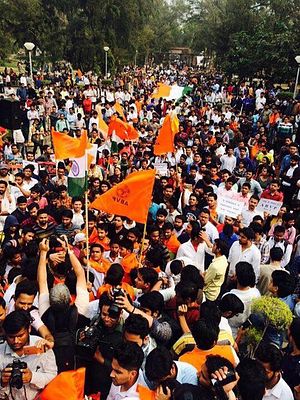Events in Indian politics over the last few weeks, when compared against this time in 2016, suggest that New Delhi is once more the site of student political activism, campus polarization, and debates over what precisely constitutes as free speech in India. A closer analysis, however, would suggest that this is perhaps reflective of trends beyond just campuses and beyond Delhi as well.
Jawaharlal Nehru University (JNU) students Umar Khalid and Shehla Rashid were invited to speak at Delhi University’s (DU’s) Ramjas College. As they were important stakeholders in the 2016 JNU protests over protests regarding the hanging of Afzal Guru, the student arrests, and the resultant debates, this invitation allegedly did not sit well with some members of the college, prominently the Akhila Bharatiya Vidyarthi Parishad (ABVP), a student group that enjoys the strong support of the right-wing Rashtriya Swayamsevak Sangh (RSS). ABVP’s protests on February 22 and 23 descended into violence against the organizers, which resulted in the withdrawal of the invitation to the speakers, which in turn sparked a domino effect, leading to more protests.
Some students and DU colleges independently organized protests of ABVP’s behavior and perceived arm-twisting. The ABVP then responded with its own protest decrying the perceived degeneration of campuses into left-leaning havens. This culminated in a Citizens’ March against the ABVP, which saw participation from students across colleges, prominent opposition party members, and everyday citizens. However, to view this as merely targeted at the ABVP would be myopic.
While the ABVP served as an important trigger for the protests by binding together its ideological and philosophical opponents, the protest was as much about the violence that student politics — in particular left-leaning student politics in India — has increasingly begun to face. Speeches at the march and in the larger debates outside of it expressed a range of emotions, from skepticism to outrage to disgust, at the willingness of organizations like the ABVP or state police forces to descend into violence in the face of opinions they deemed controversial.
The ABVP’s posters decrying the left groups have been called out for attempting to incite anger in their portrayal of mutilation and beheading. Their supporters’ reactions to a student who called them out on social media (and went viral in the process) included harassment, cyber bullying, and rape threats. The National Human Rights Commission (NHRC) issued a notice regarding police excesses against students and journalists at Ramjas College as well.
The Panjab University administration, meanwhile, warned students against organizing a seminar on rising fascism, fearing ABVP backlash. The ABVP then vociferously retaliated to and filed a police complaint against a Doon University student who made a comment about the Indian Army’s behavior in Kashmir being tantamount to rape, even though she eventually withdrew it. President Pranab Mukherjee spoke out against the “vortex of violence” on college campuses and stressed the need for free thinking and debate.
The ABVP cohort’s favorite enemies include communists and all other left groups, but most importantly the so-called anti nationals. They have slowly but surely attempted to, along with the RSS and its allies, hijack the space for debate to decide who is patriotic and who isn’t and how lack of patriotism must be treated or punished.
While the groups opposing the ABVP arguably operate in their own echo chambers, much like ABVP, the difference between them does not lie in their unwillingness to listen to others as much as in their unwillingness to let others speak. ABVP’s need to violently shut down, police, and rail against all forms of disagreement has resulted in an atmosphere of fear, self-censorship, and polarization.
For those belonging to its opposition camp, ABVP has become symbolic of a larger culture of bullying in India: a culture that holds a specific idea of nationalism, uses the idea of India as its torch, and is unafraid to set fire to those that do not adhere to or agree with these views. This bullying aims to weld solid this rather fragile idea of the Indian nation, before it is decimated by forces like diversity and plurality.
































